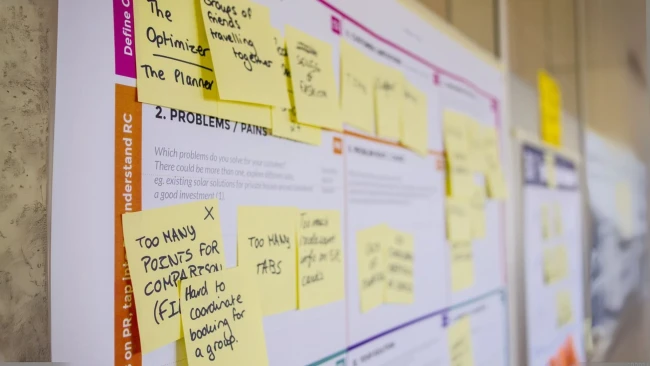
What is a Scrum/Agile approach and why use it?
Having recently qualified as a Scrum Master, I would like to share a summary of Scrum and the benefits it will bring to you our clients.
Scrum itself is a framework for project management that emphasises teamwork, accountability and iterative progress toward a well-defined goal.
There are three pillars of Scrum, which are transparency, inspection and adaptation. These behaviours we’re well embedded in Adapt already but Scrum brings a more formal process to it.
Scrum Roles
Everyone in the Scrum team plays a role. When it comes to product development, Scrum roles include the product owner, Scrum master and Scrum development team.
Product owner: This team member serves as the liaison between the development team and its customers. The product owner is responsible for ensuring expectations for the completed product have been communicated and agreed upon.
Scrum master: This team member serves as a facilitator. The Scrum master is responsible for ensuring that Scrum best practices are carried out and the project can move forward.
Scrum development team: This is a group that works together for creating and testing incremental releases of the final product.
The Scrum process
The Scrum process encourages practitioners to work with what they have and continually evaluate what is working and what is not working. Communication, which is an important part of the process, is carried out through meetings, called Events.
Scrum Events include:
Daily Scrum: The Daily Scrum is a short stand-up meeting that happens at the same place and time each day. At each meeting, the team reviews work that was completed the previous day and plans what work will be done in the next 24 hours. This is the time for team members to speak up about any problems that might prevent project completion.
Sprint Planning Meeting: A Sprint refers to the time frame in which work must be completed, and can be from 1 – 4 weeks long. Everyone participates in setting the goals, and at the end, at least one increment — a usable piece of software — should be produced.
Sprint Review: This is the time to show off the increment to the client.
Sprint Retrospective: A Sprint Retrospective is a meeting that’s held after a Sprint ends. During this meeting, everyone reflects on the Sprint process. An important goal of a Sprint Retrospective is continuous improvement.
Scrum artefacts
An artefact is something of historical interest that deserves to be looked at again. In Scrum product development, artefacts are used to see what’s been done and what is still in the queue. Scrum artefacts include the product backlog, sprint backlog, product increment and burn-down, are useful to look at in Sprint Planning Meetings.
Product backlog: This refers to what remains on the “to be done” list. During a product backlog session, the development team works with the business owner/Product Owner to prioritise work that has been backlogged. The product backlog may be fine-tuned during a process called backlog refinement.
Sprint backlog: This is a list of tasks that must be completed before the selected product backlog items can be delivered. These are divided into time-based user stories.
Product Increment: This refers to what’s been accomplished during a Sprint — all the product backlog items — as well as what’s been created during all previous Sprints. The product increment reflects how much progress has been made.
Burn-down: The burn-down is a visual representation of the amount of work that still needs to be completed. A burn-down chart has a Y axis (work) and an X axis (time). Ideally, the chart illustrates a downward trend, as the amount of work still left to do overtime burns down to zero.
Scrum values
The three pillars of Scrum — transparency, inspection and adaptation — are supported by five values: commitment, courage, focus, openness and respect.
Commitment: The team is self-directed, and all members are dedicated to completing work that has been agreed upon.
Courage: The team operates as a single entity and succeeds or fails together.
Focus:The team limits distractions and concentrates on what work needs to be done today.
Openness: The team is given time to gather and share what has been successful and what needs to be improved.
Respect: The team is composed of members who have different strengths, and each individual’s strengths are respected. There is no finger-pointing when discussing how to fix what is not working.
Key benefits of using a Scrum/Agile Methodology
These are some of the collective benefits of utilising an agile scrum methodology:
Flexibility and adaptability
Creativity and innovation
Lower costs
Quality improvement
Organisational synergy
Decreased time to market
Employee satisfaction
Customer satisfaction
The greatest benefit of agile scrum methodology is its flexibility. With the sprint-based model, the scrum team typically receives feedback from stakeholders after each sprint. If there are any problems or changes, the scrum team can easily and quickly adapt product goals during future sprints to provide more valuable iterations. This way, stakeholders are happier because they get exactly what they want after being involved every step of the way.
Compare this with traditional project management systems, in which stakeholders do not provide frequent feedback and time is wasted making changes to the product halfway through development – or, worse, the teams need to start from scratch after the product has already been built.
To implement an agile scrum methodology, there must be either a scrum expert in the company or an outside scrum consultant to ensure scrum principles are being applied correctly. Agile Scrum methodology involves precise execution, which could result in a disaster if not done properly.


